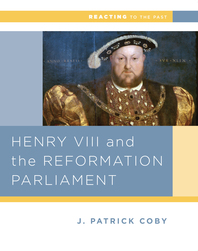
Henry VIII and the Reformation of Parliament
24 October 2014
Territory Rights — Worldwide.
Description
Part of the Reacting to the Past series, Henry VIII and the Reformation Parliament transforms students into lords and commoners and members of the English Parliament during the tumultuous years 1529–36.
Cardinal Wolsey has just been dismissed as Lord Chancellor for failing to obtain an annulment of King Henry’s marriage to Catherine of Aragon. Thomas More is named as Wolsey’s replacement. More presides over Parliament, which the king hopes will somehow find the means to invalidate his marriage, thus freeing him to marry his new love, Lady Anne Boleyn. Apart from matters of the heart, matters of state also apply, for Henry has no male heir to carry on the Tudor line, and Queen Catherine has passed her child-bearing years.
But will Parliament be content with solving the king’s marital and dynastic problems? For there are some in Parliament who wish to use the royal divorce to disempower the English church, to sever its ties to papal Rome, and to change it doctrinally from Catholicism to Protestantism. Others are against the divorce, against supremacy and independence, and against this heretical creed filtering in from the Continent. More is their leader, for as long as he can survive. Thomas Cromwell leads the king’s party.
The king is ambivalent about the reformation unleashed by his "great matter," as the divorce campaign is called, and so the conservatives are free to prosecute reformers as heretics, while the reformers are free to prosecute conservatives as traitors. Victory is up for grabs, because the king’s party is in fact a coalition of three dissimilar factions whose members are further divided by personal ambitions and jealousies. At issue is the clash of four contending ideas: medieval Catholicism, Lutheranism, Renaissance humanism and Machiavellian statecraft.


